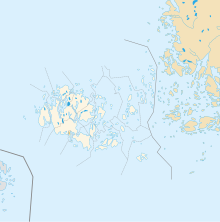Jet oils
Coordinates: 60 ° 8 ′ 31 ″ N , 19 ° 57 ′ 58 ″ E
Jettböle in Jomala is a two-phase dwelling place on the Finnish Åland Islands, which was settled in the final phase by the Pit Pottery Culture (2500–2000 BC). The course is located on the south coast of the main island, in the northeastern outskirts of the capital Mariehamn .
- Jettböle I ( hunters and gatherers of the eastern group) with pointed-bottom vessels, horizontal decoration (pits and comb stitches) at about the same time as the Sater III style
- Jettböle II ( corded ceramists of the western group) with flat-bottomed vessels decorated with comb stamps without pits, which roughly correspond to the Sater IV style.
The settlement of the Åland Islands is well documented due to archaeological excavations. The first humans have lived around 4000 BC. Settled on the archipelago . Most of the places where they lived were excavated near Langbergsöda ( Saltvik municipality ). The finds suggest that they came from the east (Jettbölle I). However, genetic analyzes from 2015 suggest that they came from the west. Their ancestors are among the hunters and gatherers of the Suomusjärvi culture (between the 9th and 6th millennium), the Komsa culture , the Forsa culture and Bromme culture or the much earlier continental Ahrensburg culture or Hamburg culture (13,700– 12,200 BC). The impression of a settlement from the east arose from a local settlement movement of hunters and gatherers directed against the expansion. They lived from fishing and hunting ringed seals and sea birds .
Around 2500 BC They were replaced by settlers who came from southern Sweden (Jettbölle II) and represented a penetration of the Mesolithic Ertebölle culture with the northern group of the Funnel Beaker Culture (TBK), which reached Åland via Denmark and southern Sweden.
Like their predecessors, they also settled near the coast, but their living space is 30 to 35 m above sea level due to the land elevation . These newcomers also hunted and caught fish. Finds of fine-meshed nets and the fish waste from cod (Gadus morhua) and herring (Clupea harengus) come from Ajvide , Gotland , Sweden and Jettböle. Modest animal husbandry ( cattle , sheep / goats and pigs ) and possibly the cultivation of barley show the influence of the Neolithic neighbors. Finds of earth ovens, stoves and fireplaces complete the picture.
The Jettböle finds of a ritual nature, like comparable sites of the dimpled ceramics, show that around 60 clay idols probably represent gods (men and women) known from more eastern cultures.
At best, there are parallels between the head shapes of these idols and the later wooden anthropomorphic pole gods , whose first find on the Belarusian-Russian border was dated around 11,000 years ago and which were particularly salvaged from the moors of northern Europe and southern Scandinavia. The Vogelherd figures made of ivory also show certain approaches that are similar to those of Jettböle. Even before the immigration of Anatolian farmers in the east of the European continent, clay processing is documented.
Although Jettbölle differs significantly, there are definitely forms in Eastern and Central Europe that were made a few millennia earlier. This points to ancient traditions that have been maintained here for a particularly long time. The question of cannibalism is also discussed in connection with the grave finds, and parallels to the 7,000-year-old site in Herxheim, Palatinate, are also evident .
A study taking into account human remains, DNA and ceramic decorations examines the spatial connections and landfill patterns of the find categories. The character and importance of the site turned out to be more complex than assumed. The DNA examinations are just as complicated, since the settlers from Jettbölle I and Jettbölle II were quite closely related overall.
In the meantime, the theory of a much later language change between the Saami primitive group and today's Saami language is being discussed, which was triggered by the immigration of reindeer herders with the Finno-Ugric language. The immigration of corded ceramics suggests that Jettböle II was already Indo-Germanized.
literature
- Alexandra Strömberg, Daniel Anderberg: A Research Overview and Discussion of the Late Neolithic and the Bronze Age on Åland . In: Gotland University Press . Vol. 5, 2010, ISSN 1653-7424 , pp. 23-37 . ( Full text as digitized version)
- Anders Götherström, Niklas Stenbäck, Jan Storå: The Middle Neolithic site of Jettböle on the Åland Islands - Human Remains, Ancient dna and Pottery. In: European Journal of Archeology. Vol. 5, No. 1, 2002, ISSN 1461-9571 , pp. 42-68, doi : 10.1177 / 1465712002005001170 .
Movie
- Cannibals - In the Heart of Europe? Documentation by Jeanine Isabel Butler, National Geographic (Great Britain, 2011, 51 min)
Web links
- Overview map of the location of Jetböle in the south of the archipelago
- Description Dimple ceramic with a picture of an idol
Individual evidence
- ^ Milton G. Nunez, 1986, CLAY FIGURINES FROM THE ALAND ISLANDS AND MAINLAND FINLAND
